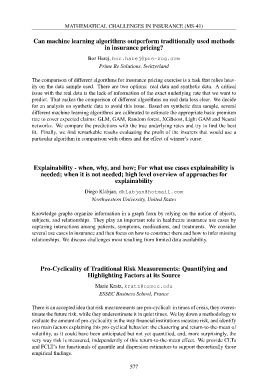Page 579 - 8th European Congress of Mathematics ∙ 20-26 June 2021 ∙ Portorož, Slovenia ∙ Book of Abstracts
P. 579
MATHEMATICAL CHALLENGES IN INSURANCE (MS-41)
Can machine learning algorithms outperform traditionally used methods
in insurance pricing?
Bor Harej, bor.harej@prs-zug.com
Prime Re Solutions, Switzerland
The comparison of different algorithms for insurance pricing exercise is a task that relies heav-
ily on the data sample used. There are two options: real data and synthetic data. A critical
issue with the real data is the lack of information of the exact underlying rate that we want to
predict. That makes the comparison of different algorithms on real data less clear. We decide
for an analysis on synthetic data to avoid this issue. Based on synthetic data sample, several
different machine learning algorithms are calibrated to estimate the appropriate basic premium
rate to cover expected claims: GLM, GAM, Random forest, XGBoost, Light GAM and Neural
networks. We compare the predictions with the true underlying rates and try to find the best
fit. Finally, we find remarkable results evaluating the profit of the insurers that would use a
particular algorithm in comparison with others and the effect of winner’s curse.
Explainability - when, why, and how; For what use cases explainability is
needed; when it is not needed; high level overview of approaches for
explainability
Diego Klabjan, dklabjan@hotmail.com
Northwestern University, United States
Knowledge graphs organize information in a graph form by relying on the notion of objects,
subjects, and relationships. They play an important role in healthcare insurance use cases by
capturing interactions among patients, symptoms, medications, and treatments. We consider
several use cases in insurance and then focus on how to construct them and how to infer missing
relationships. We discuss challenges most resulting from limited data availability.
Pro-Cyclicality of Traditional Risk Measurements: Quantifying and
Highlighting Factors at its Source
Marie Kratz, kratz@essec.edu
ESSEC Business School, France
There is an accepted idea that risk measurements are pro-cyclical: in times of crisis, they overes-
timate the future risk, while they underestimate it in quiet times. We lay down a methodology to
evaluate the amount of pro-cyclicality in the way financial institutions measure risk, and identify
two main factors explaining this pro-cyclical behavior: the clustering and return-to-the-mean of
volatility, as it could have been anticipated but not yet quantified, and, more surprisingly, the
very way risk is measured, independently of this return-to-the-mean effect. We provide CLTs
and FCLT’s for functionals of quantile and dispersion estimators to support theoretically those
empirical findings.
577
Can machine learning algorithms outperform traditionally used methods
in insurance pricing?
Bor Harej, bor.harej@prs-zug.com
Prime Re Solutions, Switzerland
The comparison of different algorithms for insurance pricing exercise is a task that relies heav-
ily on the data sample used. There are two options: real data and synthetic data. A critical
issue with the real data is the lack of information of the exact underlying rate that we want to
predict. That makes the comparison of different algorithms on real data less clear. We decide
for an analysis on synthetic data to avoid this issue. Based on synthetic data sample, several
different machine learning algorithms are calibrated to estimate the appropriate basic premium
rate to cover expected claims: GLM, GAM, Random forest, XGBoost, Light GAM and Neural
networks. We compare the predictions with the true underlying rates and try to find the best
fit. Finally, we find remarkable results evaluating the profit of the insurers that would use a
particular algorithm in comparison with others and the effect of winner’s curse.
Explainability - when, why, and how; For what use cases explainability is
needed; when it is not needed; high level overview of approaches for
explainability
Diego Klabjan, dklabjan@hotmail.com
Northwestern University, United States
Knowledge graphs organize information in a graph form by relying on the notion of objects,
subjects, and relationships. They play an important role in healthcare insurance use cases by
capturing interactions among patients, symptoms, medications, and treatments. We consider
several use cases in insurance and then focus on how to construct them and how to infer missing
relationships. We discuss challenges most resulting from limited data availability.
Pro-Cyclicality of Traditional Risk Measurements: Quantifying and
Highlighting Factors at its Source
Marie Kratz, kratz@essec.edu
ESSEC Business School, France
There is an accepted idea that risk measurements are pro-cyclical: in times of crisis, they overes-
timate the future risk, while they underestimate it in quiet times. We lay down a methodology to
evaluate the amount of pro-cyclicality in the way financial institutions measure risk, and identify
two main factors explaining this pro-cyclical behavior: the clustering and return-to-the-mean of
volatility, as it could have been anticipated but not yet quantified, and, more surprisingly, the
very way risk is measured, independently of this return-to-the-mean effect. We provide CLTs
and FCLT’s for functionals of quantile and dispersion estimators to support theoretically those
empirical findings.
577


